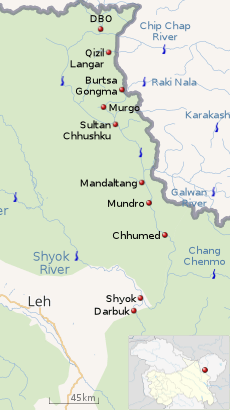Darbuk–Shyok–DBO Road
Darbuk–Shyok-DBO Road (DS-DBO Road/DSDBO Road), also called the Sub-Sector North road,[2] is an all-weather road in eastern Ladakh in India,[3] close to the Line of Actual Control with China. It connects Ladakh's capital city Leh, via the villages of Darbuk and Shyok at southern Shyok Valley, with the Daulat Beg Oldi (DBO) post near the China border. The 220-km long section between Shyok and DBO was constructed between 2000 and 2019 by India's Border Roads Organisation (BRO).[1][4]
| Darbuk–Shyok–DBO Road | |||
|---|---|---|---|
| Sub-Sector North Road | |||
| Route information | |||
| Maintained by Border Roads Organisation | |||
| Length | 255 km[1] (158 mi) | ||
| Existed | April 2019–present | ||
| Major junctions | |||
| From | Leh | ||
| Darbuk Shyok | |||
| To | Daulat Beg Oldi (DBO) | ||
| Location | |||
| Districts | Leh district (Nubra) | ||
| Highway system | |||
| |||
Route
The BRO road begins near the village of Shyok, which is the on the west bank of the Shyok River after its V-shaped bend. Shyok already has roads leading west, to Leh via Darbuk, and south, leading to Pangong Tso. The BRO road crosses the Shyok river to its right bank and rounds the corner, continuing along its right bank due north (on the west side of the river bed).
After passing the villages of Chhumed, Mundro and Mandaltang, it crosses the river near Sultan Chhushku. A 430-metre-long bridge over the full width of the river bed has been constructed and named the 'Colonel Chewang Rinchen Setu'.[lower-alpha 1]
After the Setu, the road cuts through valleys of streams to reach the village of Murgo, which is on an old caravan route between Leh and the Karakoram Pass. The road follows the caravan route, passing by the campgrounds of Burtsa and Qizil Langar, close to the Line of Actual Control with China.[lower-alpha 2]
Construction
The construction was initiated 2000, with a revised deadline of 2014. However, in 2011, an inquiry by the Chief Technical Examiner found that three-quarters of the road had been laid on the river bed, which is unsuitable for military use. A new Border Roads Task Force from Jammu was then commissioned to realign the constructed road on higher ground and to complete it. The revamped project was scheduled for completion in 2017 but was eventually completed in April 2019. The old alignment was used in intervening period during the winter months.[7]
Notes
- The bridge has been named after a hero of Ladakh, Chewang Rinchen, who organised the Ladakhi resistance to the Gilgit Scouts invasion during the Indo-Pakistani War of 1947. He received Maha Vir Chakra, India's second higest military honour, twice in his life time.[5]
- The old caravan route is marked on the map provided by Maj. Gen. Vombatkere.[6]
References
- Ajay Banerjee, India completes vital Ladakh road, The Tribune (Chandigarh) 22 April 2019.
- "Amid Ladakh standoff with China, India puts border roads in fast lane".
- "Explained: The strategic road to DBO".
- Lt Gen Prakash Katoch, DSDBO Road completed – but what of the scam and the northeast?, Indian Defence Review, 27 April 2019.
- PTI, India's Highest Altitude All-weather Permanent Bridge Inaugurated by Rajnath Singh in Eastern Ladakh, News18, 21 October 2019.
- Maj Gen S. G. Vombatkere, A Ring-Side View Of The Chinese Incursion, Countercurrents.org, 7 May 2013.
- Sushant Singh, Constructed on riverbed, road to China border being rebuilt, The Indian Express, 4 June 2015.
External links
- Prateek Joshi, India’s Growing Military Footprint in Eastern Ladakh: Facing China, CogitAsia, Center for Strategic & International Studies, 26 July 2016.
- Alice G Wells, Why Ladakh road built last year has been a thorn in China's flesh, Economic Timems Prime, 20 May 2020.
